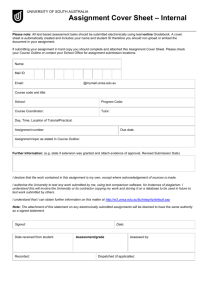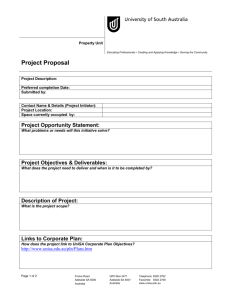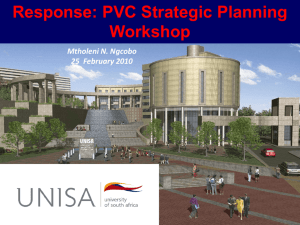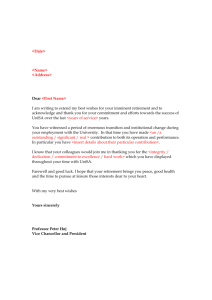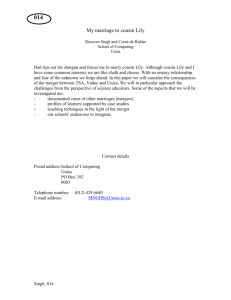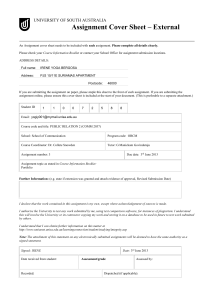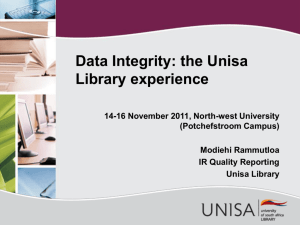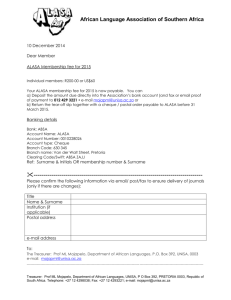Unisa's Integrated Student Success & Support Frameworks
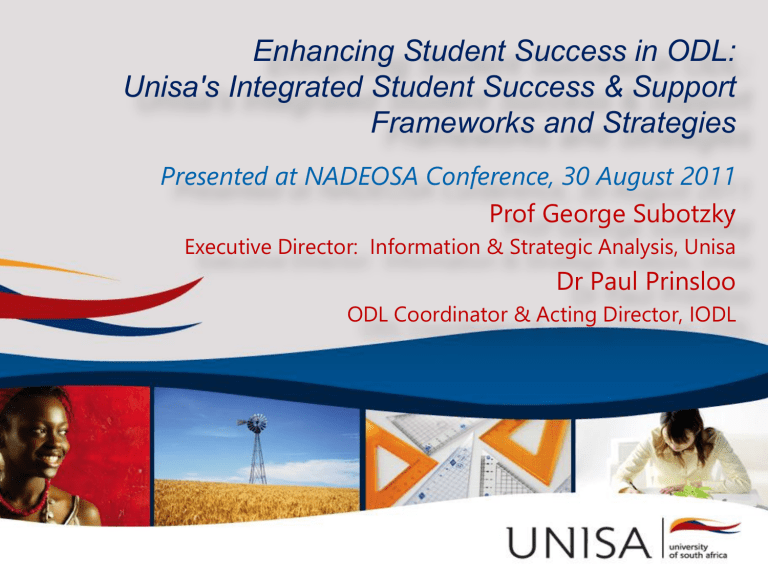
Enhancing Student Success in ODL:
Unisa's Integrated Student Success & Support
Frameworks and Strategies
Presented at NADEOSA Conference, 30 August 2011
Prof George Subotzky
,
Executive Director: Information & Strategic Analysis, Unisa
Dr Paul Prinsloo
ODL Coordinator & Acting Director, IODL
Acknowledgements
• The efforts of numerous DISA staff members in gathering and preparing information is acknowledged
• In particular, the help and support of Robert Lightbody, admin Asst/caregiver to Prof Subotzky, was invaluable in preparing this presentation
Background
• Enhancing student success is a worldwide challenge
• This challenge is particularly formidable at Unisa, which now has +340 000 mainly non-traditional, older, part-time, underprepared students
• They face challenging socio-economic circumstances, particular work-related and domestic responsibilities, which impede on student success
Focus
• To address this, Unisa recently developed an integrated Student Support & Success framework, which is a central component of the implementation of its ODL plan
• This presentation focuses on:
• A brief background
• Elements of the framework
• The conceptual model of all factors impacting on student success
• The profiling, assessing & predictive modelling of risk
• An overview of the tracking system
• Key assumptions & principles of student support
National 5-Year Graduation, Retention & Attrition Rates, 2000
Cohort
Graduated within 5 years
Still registered after 5 years
Left without graduating
Institutional Type
Universities
(excluding Unisa)
Unisa
All Universities
Technikons
(excluding TSA)
Technikon SA
All Technikons
All Institutions
50%
14%
38%
32%
2%
23%
30%
12%
27%
17%
10%
12%
11%
14%
38%
59%
45%
58%
85%
66%
56%
Source: Scott et al, 2007
The Nature of the Problem
• Unisa’s course success rate has steadily risen to 62,4% in
2010 – just below the new 2013 ministerial target of
63%
• Cohort analyses indicate that:
– First-year dropout in various qualification levels can be as high as 70%
– Many students stop out of studies more than once for various academic and non-academic reasons
– Time-to-completion is generally satisfactory
• The main challenge in improving student success remains retention
Imperatives to address the problem
• Unisa has a moral obligation to ensure that enhancing student access in the ODL environment is accompanied by effectively enhancing success
• Persistent failure and dropout has significant financial implications for students and, increasingly, for Unisa
• Ongoing poor success, retention and graduation rates diminish student and staff morale as well as institutional reputation
Unisa’s Student Success Framework
Conceptual
Modeling
Identifying what is relevant, measurable, available & actionable
Data Gathering via
Tracking
System, including
Surveys
Statistical &
Analytic
Modelling producing
Actionable
Intelligence
Student
Support
Framework
M & E
SHAPING CONDITIONS: (predictable as well as uncertain)
• Social structure, macro & meso shifts: globalisation, political economy, policy; National/local culture & climate
• Personal /biographical micro shifts
STUDENT
IDENTITY & ATTRIBUTES:
• Situated agent: SES, demographics
• Capital: cultural, intellectual, emotional, attitudinal
• Habitus: perceptions, dispositions, discourse, expectations
THE STUDENT WALK:
Multiple, mutually constitutive interactions between student, institution
& networks
• Managing complexity/ uncertainty/ unpredictability/risks/opportunities
• Institutional requirements known & mastered by student
• Student known by institution through tracking, profiling & prediction
INSTITUTIONAL
IDENTITY & ATTRIBUTES:
• Situated organisation: history, location, strategic identity, culture, demographics
• Capital: cultural, intellectual, attitudinal
• Habitus: perceptions, dispositions, discourse, expectations
TRANSFORMED STUDENT IDENTITY & ATTRIBUTES:
• Informed responsibility & ‘choice’
•
•
Processes:
Ontological/epistemological dev.
Managing risks/opportunities/ uncertainty: Integration, adaptation, socialisation & negotiation
Domains:
• Intrapersonal
• Interpersonal
Modalities:
• Attribution
• Locus of control
• Selfefficacy
I
F
T
I
F
T
I
F
T
I
F
T
I
F
T
Choice,
Admission
Retention/Progression/Positive experience
Learning activities
Course success
Graduation
Employment/ citizenship
I
F
T
I
F
T
I
F
T
I
F
T
I
F
T
•
TRANSFORMED INSTITUTIONAL IDENTITY & ATTRIBUTES:
Processes:
• Informed responsibility & choice
Managing risks/opportunities:
Transformation, change management, org. learning, integration & adaptation
Domains:
• Academic
• Operational
• Social
Modalities:
• Attribution
• Locus of control
• Selfefficacy
FIT
Success
FIT
SHAPING CONDITIONS: (predictable as well as he uncertain)
• Social structure, macro & meso shifts: globalisation, internationalisation, political economy, technology, social demand
• HE/ODL trends, policy
• Institutional biography & shifts; Strategy, business model & architecture, culture & climate, politics & power relations
Inter-Personal
Background:
• Demographics
• Past SES
- Educ. Background
- Family Background
- Role Models
Current SES & Life
Circumstances:
- Time &
Opportunity
- Stability & Support
Integration, Engagement & Transformation
Student’s Effective Management of:
• Life Circumstances & Risks
• Learning Expectations & Opportunities
Fit: Academic
Choices &
Activities
Utilisation of
Admin/
Support
Services
Fit with
Institutional
Culture &
Practices
Institution’s Effective Management of:
• Academic & Support Processes/Risks
• Student Profile/Risk & Communication
Institutional Services, Practices & Culture
Quality of
Academic
Services
Quality of
Admin
Services
Social:
Institutional
Culture &
Practices
Academic
Readiness &
Ability
Student as Situated Agent
Intra-Personal
Meta-
Cognitive
Skills
Psychological
Attributes &
Outcomes
Formative
Assessment
•
•
Success
Course
Success
Satisfaction
Graduateness
Student Walk
Graduation
Institution as Situated Agent
Proposition 1
Student success is broadly interpreted as course success, retention, progression through the main phases of the student walk, and ultimately successful graduation and effective entry into the labour market and/or citizenship.
Success also incorporates a positive student experience as a result of student-centred service excellence and efficient operations provided by the institution.
Proposition 2
Student success and positive experience is the outcome of sufficient fit between the transforming identity, attributes and performance of both the student and the institution through all phases of student walk.
Proposition 3
Fit arises when elements of the student and institutional identity and attributes (capital and habitus) are optimally aligned at each successive stage of the student walk. Fit at these various points is the outcome of the specific individual student and institutional preconditions.
Proposition 4
In order for fit to arise at each successive stage of the student walk, relevant transformative changes in the identity and attributes of the student and the institution are required.
Proposition 5
The student walk comprises a series of multiple, mutually constitutive interactions between the situated student and the situated institution and between the student and his/her various networks through all points of the walk
(Articulation with ODL model)
Proposition 6
The formation and transformation of student and institutional identity and attributes is continuously shaped by overarching conditions at the macro, meso and micro levels
Assessing Academic Risk
• It is self-evident that the lack of academic readiness
constitutes a major risk to student success.
• DCCAD has developed an instrument for academic self-
assessment, to be administered during the second half of 2011.
• The tracking system tracks, profiles & predicts
academic risk, utilising the predictive model, drawing from all factors identified through statistical analysis
• As indicated, all this information will be circulated to
relevant roleplayers in the Student Support Framework
Assessing & Addressing Non-Academic
Risk
• In the ODL context, non-academic factors impact strongly on student success.
• Tracking, profiling and prediction of students' non-academic
readiness/risk is therefore essential to the integrated student success and support frameworks.
• A key source of information is the Student Profile Survey which provides information on:
• students' socio-economic and educational background,
• current socio-economic status and life circumstances,
• metacognitive skills and knowledge and
• psychometrics focusing on relevant attributes and aptitudes.
• This information allows the segmented profiling of Unisa's highly heterogeneous student population. This involves the definition of various student risk categories, based on the permutations of three key student-related factors impacting on success, namely: academic ability, metacognitive/psychological attributes and skills, and life circumstances.
Assessing & Addressing Institutional Risks
• The conceptual model identifies mutual responsibility for success
• Assessing & addressing all institutional risks is therefore a central component of the framework
• The tracking system, as part of Unisa’s emerging
Organisational Intelligence Framework, tracks all relevant academic, operational and administrative processes to provide dashboard scorecards and early alerts of identified risks to relevant roleplayers
• Other processes such as QA, risk management and
internal audit processes also contribute to mitigate risks
Overview of the Tracking System
• It incorporates relevant student and institutional information, academic and non-academic information and qualitative and
quantitative information.
• It tracks students' academic progress at the institutional, college, school/department, qualification and course levels.
• It also tracks key administrative and academic processes
• It provides customised automated early warnings of studentrelated and institutional risks to success.
• These are circulated to the appropriate roleplayers (tutor, e-tutor, e-coach, counsellor, lecturer, supervisor, administrative & support departments) within the student support framework, according to approved procedures, roles and responsibilities.
• By means of segmentation techniques and data mining, risk
profiles of students can be created utilising the tracking system information and other sources so that at-risk groups can be targeted for specific proactive support interventions.
Senate
STLSC
School/College TLSC Student Success Forum
Academic Department Professional Structures Admin Structures
Lecturer/Supervisor/Online
Mentor/Tutors/Regions
TSDL DCCAD
DISA
DSAR
SMPPD
DSAA
Student Support Coordinator
USGS Dean of Stud.
Academic Affective Admin
TRACKING SYSTEM
Profiling, Tracking & Predicting Risk at the level of Student/Module/Qualification/Institution
Student Information
• Applications/Registration
• HEMIS
• Assessment Performance/Scores
• Academic Readiness Self-Assessment
• Student Profile Survey
• Student Satisfaction Survey
• Exit/Tracer Surveys
• ICMAs
Operational Processes
• Application/Registration
• Study Material
• Assessment Management
• Finance
• HR
Communication/Engagement
• College/School/Department/Regions
• E-Tutor/F2F Tutor/Online Mentor
• Counsellor
• Call Centre
• Admin Department
• Tutorial Attendance
• myUnisa/Library
• Student Course Evaluation
The Unisa Student Support Framework describes student support as...
i. Student-centred ii. Efficient and affordable iii. Formalised and planned as well as informal and spontaneous iv. Integrated coherently into the main learning experience
• curriculum planning
• planning of formative and summative assessment
• offering of tutorial and counselling services and
• the use of technologies. v. Offering appropriate, and where possible, customized student support
Unisa Student Support Framework
Identifies three distinct (but related and often overlapping) phases for student support:
• Entry phase (advising, profiling, diagnostic testing, orientation, etc)
• Teaching and learning phase (cognitive and emotional development, formative and summative assessment, student tracking system and timely interventions)
• Exit phase (towards registration, graduation, lifelong learning, etc)
The implementation of the above conceptual framework sees the roll-out of three types of student support, namely
•
Administrative support (registration, assignments, materials, etc)
•
Academic support (cognitive subject related support)
•
Affective or pastoral support (emotional, personal development support)
Key Principles & Assumptions
i. Not all students require the same type of support (academic, non-academic and administrative) throughout the whole of the semester, or at all. ii. Not all students want the same type of support iii. Not all students who need different types of support recognise or acknowledge this. iv. Unisa commits itself to provide all students with wellintegrated systems and effective systemic support. v. Any student should have access to reliable and effective support when they need it.
Key Principles & Assumptions (2)
vi. Unisa proactively identifies students’ potential and risk and provides appropriate support for students to develop their potential and to address their risks through well-designed and appropriate interventions based on a careful segmentation of students’ potential and risk-profiles. vii. Self-assessment of potential and risk is a crucial part of increasing the self-efficacy of students and ensuring that students are aware of their potential for being successful and/or risk of failure. viii. Students’ needs for support differ according to different factors which identified in the conceptual and predictive models.
Key Principles & Assumptions (3)
ix. Student support (academic and non-academic support) does not need to be face-to-face. There is a range of technologies available which allows student support at
Unisa to take advantage of synchronous and asynchronous forms, which, if used appropriately and effectively, may form part and parcel of a total student support strategy. x. Student support contains both academic and non-academic elements and is delivered in an integrated and wellcoordinated way by different stakeholders, internally and externally (such as industry, etc).
Conclusion
• To address the imperatives of enhancing student success, Unisa has developed an integrated student support and success framework comprising:
• Conceptual and predictive modelling of academic, nonacademic (affective & administrative) risk
• Gathering required information by the tracking system and other sources
• Analysing this information in order to track, predict and profile risk
• Addressing this through the Student Support Framework
• Evaluating impact over time
• Feedback has indicated that the framework is innovative, cuttingedge and in alignment with best practice
• Over time, the effectiveness of the conceptual and practical foundations of the framework will become apparent
